Copy Sentence Showing top 8 worksheets in the category - Copy Sentence. Some of the worksheets displayed are Four types of sentences, The wold sentence copy test, First grade sentence structure, Writing simple sentences, Incomplete sentences, Topic sentences work 1 what is a topic sentence, Cursive writing practice.
The Wold sentence copy test was created by Bob Wold, an American optometrist in 1970. In 1995 the Wold Sentence Copy test was modified to extend its measurement range and refine the norms. The new version, called the Wold - Pacific Copy Test, includes sub-tests for number and letter copying. Occupational therapy may be recommended to promote optimal motor skill acquisition. Treatment may address gross motor and sensory-motor development, eye-hand coordination, appropriate interaction with toys, training in handwriting, visual-perceptual skills required for playing and reading, self-care abilities, and sensory processing. Write and copy of a child. Most daily activities in school require writing and copying, so it is very important to know the child’s visual motor state. A test has been validated in the U.S.A. (The Wold Sentence Copy Test) useful as a predictor of the presence of visual motor deficits related to poor academic performance. Home December 1995 - Volume 72 - Issue 12 NORMATIVE AND RELIABILITY DATA FROM THE WOLD SENTENCE COPY T. Log in to view full text. If you're not a subscriber, you can.
The following tests may be given to your child to obtain information to help further assess their skills and improve functional performance in their daily lives.
The Print Tool
Would you like more information on how you may help your own child with their handwriting?
The Print Tool is a completed printing assessment for students age six and older. It not only pinpoints exactly where a child is having difficulty with is/her handwriting, but then suggests a remediation plan. The Print Tool is comprehensive and is appropriate for students using any curriculum. This assessment may take approximately 20 mins. to administer and the scores for specific skills show student strengths and needs. The Print Tool assesses eight handwriting components for printed capitals, lowercase letters and numbers.
- Memory - Remembering and writing dictated letters and numbers
- Orientation - Facing letters and numbers in the correct position
- Placement - Putting letters and numbers on the baseline
- Size - How big or small a child chooses to write
- Start - Where each letter or number begins
- Sequence - Order and stroke directions of the letters or number parts
- Control - Neatness and proportion of letters and numbers
- Spacing - Amount of space between letters in words, and between words in sentences

********************************
Bruininks-Oseretsky Test of Motor Proficiency, Second Edition (BOT-2)
This test has several subtests . The subtest of Fine Motor Precision consists of activities that require precise control of finger and hand movements such as drawing, cutting and folding of paper. The subtest Fine Motor Integration looks at the student's ability to look at a design, analyze it and copy the design. Subtest three, Manual Dexterity, is a timed test that involves reaching grasping and bimanual coordination of small objects.
This test may be used with ages 4-21.11 years.
Call for fee information.
*******************************
The Berry-Buktenica Developmental Test of Visual-Motor Integration (Beery VMI)
The purpose of the VMI is to help identify significant difficulties that some children have in integrating, or coordinating, their visual perceptual and motor abilities. Visual motor integration skills are needed when learning how to write in cursive and to draw or illustrate pictures.
This test may be used with ages 2 to 18.11 years.
Call for fee information.
*****************************
Wold Sentence Copying Test
This test measures the speed of printing equivalent to grade levels.
Int is appropriate for grades 2 though 8th.
Call for fee information.
Is The Wold Sentence Copying Test Standardized Testing
*****************************
Motor-Free Visual Perception Test
This visual perception test avoids any motor involvement. It focuses on five perceptual areas: spatial relationships, visual discrimination, figure-ground, visual closure and visual memory.
It is appropriate for ages 4-17 years.
Call for fee information.

*******************************
